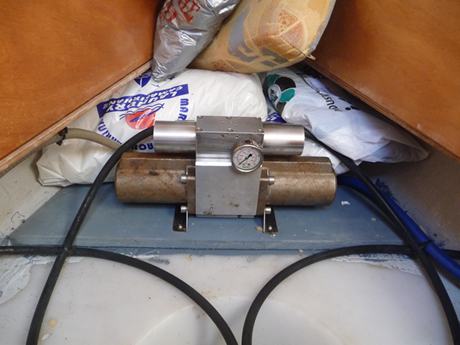Watermaker

Ile Jeudi
Bob and Lin Griffiths
Mon 17 Dec 2012 17:02
|
Thursday 13 to Monday 17 December 2012
Jean-Marie managed to come to the boat on Thursday
to take out the old membrane from the Watermaker. They are supposed
to last about 6 or 7 years and ours was 10 years old but had been in use for
8. He wasn't able to remove it from it's tube so had to take the whole
tube away to his workshop.
He came back on Friday and with the new
membrane fitted and put it all back together on the boat. We then started the watermaker to test it and both the high
low and high pressure sections of the system were low on pressure. I had
noticed the low pressure side gradually falling for some time and had
hoped that the new membrane would improve it. Grasping at straws here and
of course it didn't. We did some tests around the system and Jean-Marie
initially felt we needed a new electric pump (expensive) but later proved
it was fine. What a relief. Instead it looks like the problem is
with the high pressure pump (very expensive). Oh good.
J-M needed to discuss the options with the
manufacturer, Eco-Sistems, based in Barcelona. As usual when we have a
boat problem it takes place on a Friday afternoon, so nothing more
could be done until Monday.
On Monday J-M established that a kit of service
parts for the high pressure pump should resolve the issue and these were
ordered. They are unlikely to arrive this week and there will be no
activity next week as it is Christmas so it looks like we will have to wait for
a while.
We considered leaving the watermaker for now and
sailing without it but having had a fully functioning one for several years in
the Med, where we didn't really need it, we decided we would like to get it up
to speed again for the Atlantic crossing and the Caribbean, where we will need
it. We can carry 550 litres of water in the tanks and will take a lot of
bottled water as well but a functioning watermaker should ensure we can have a
few more showers at sea.
Part of the watermaker system under the bunk in the
forward cabin, but above one of the water tanks. The white tube contains
the 4ft membrane through which seawater is forced under pressure:-
 Under reverse osmosis we get drinkable water.
We can produce about 40 litres of freshwater an hour but need to run the
engine or generator to power it as the drain on the batteries is too
high. It's difficult to carry enough water for 3 weeks at sea but
you still have to carry enough diesel to run the generator to
produce more! The trade off is that the engine will use 4 to 5 litres
in the hour it takes to produce 40 litres of water. This is part of the
reason we have been seeking alternative ways of charging the batteries such as
solar panels and a towed generator.
The high pressure pump which operates at around 60
bar:-
 |